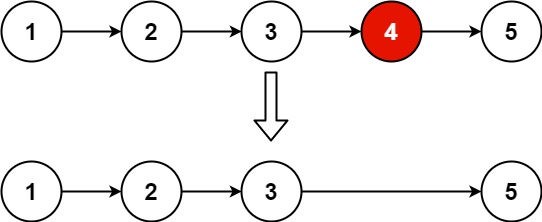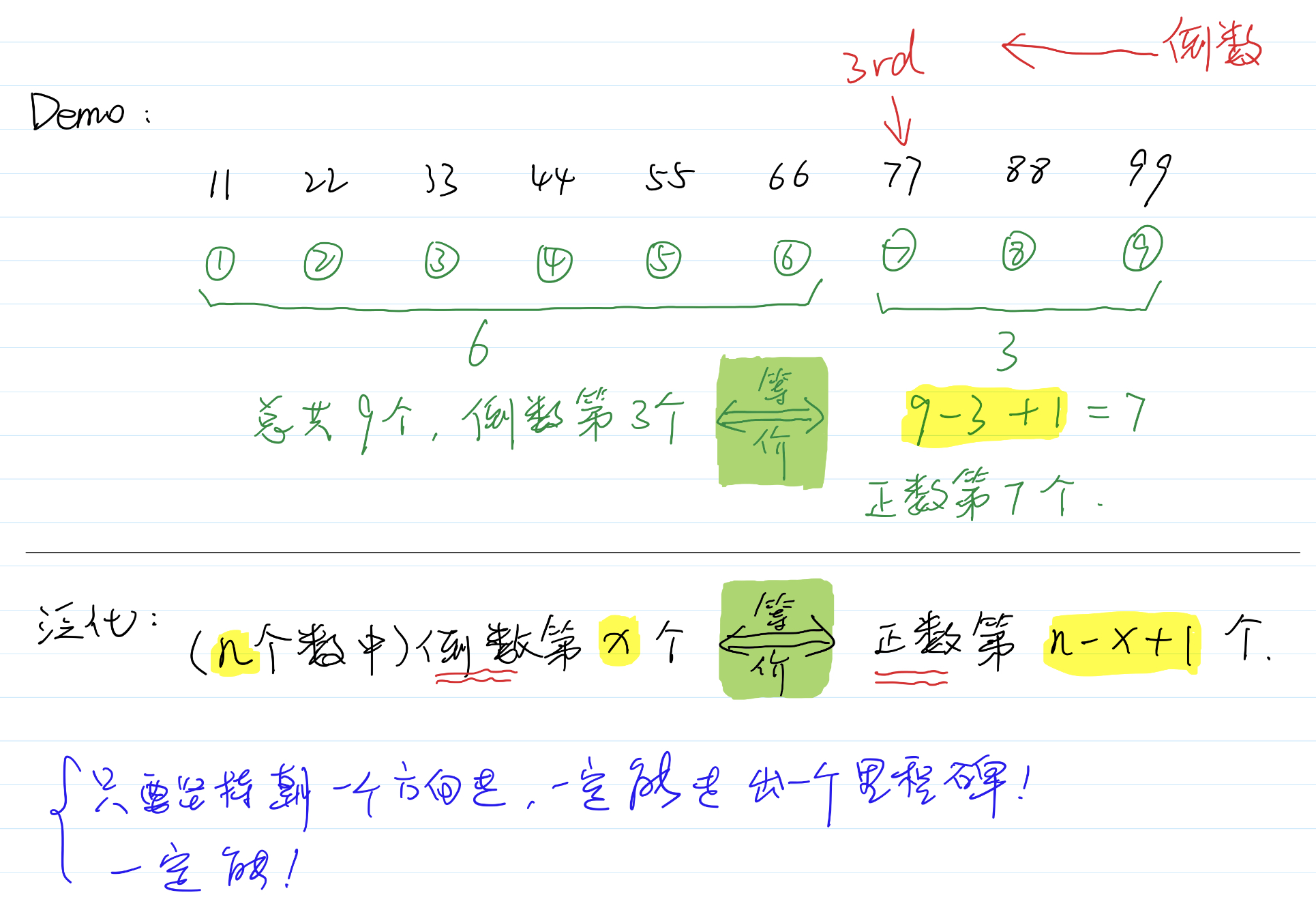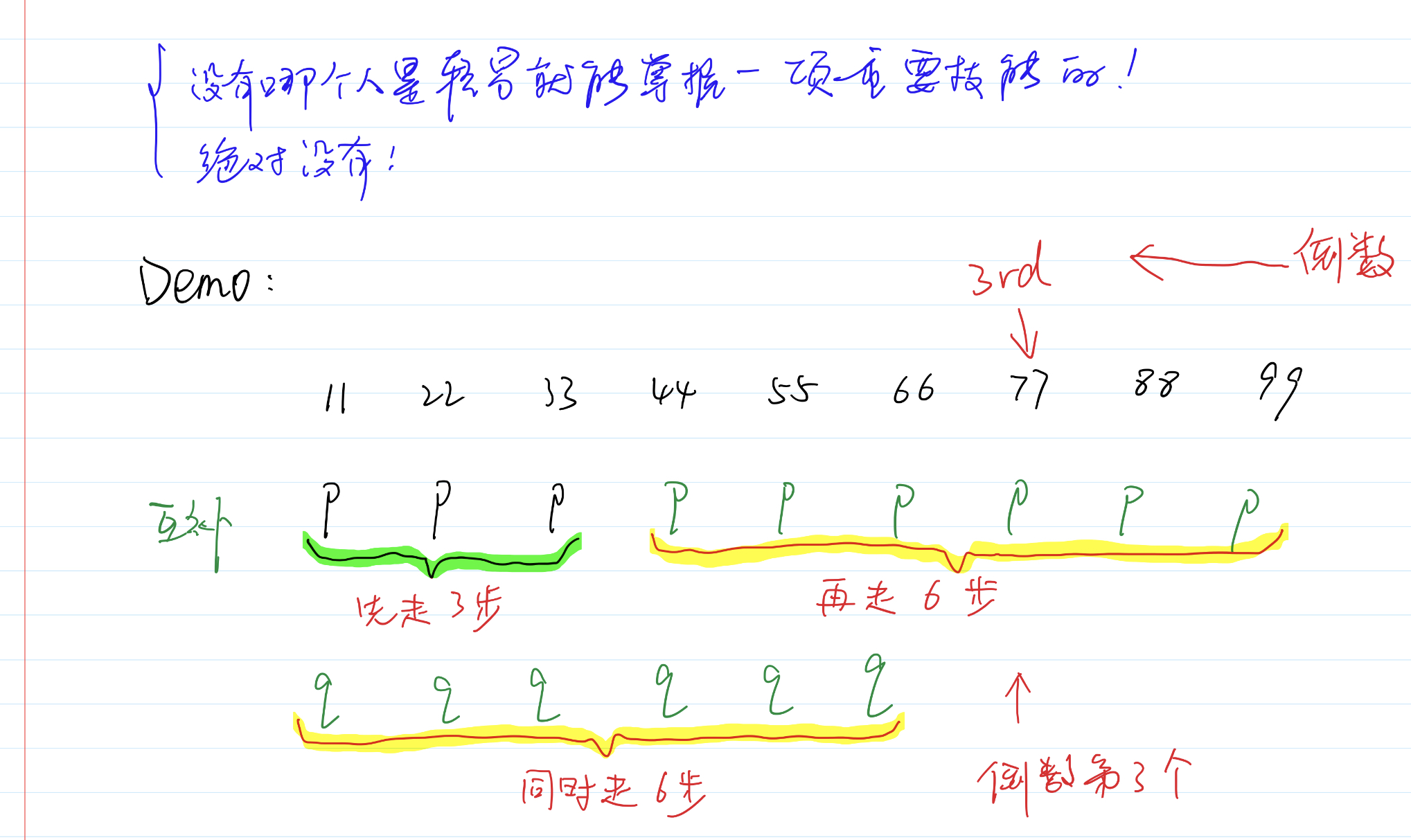[Coding012] LeetCode 19
Remove Nth Node From End of List
Ben
2023/08/02
Get the knowledge flowing and circulating! :)
目录
题目:19. Remove Nth Node From End of List
Given the head of a linked list, remove the nth node from the end of the list and return its head.
Example 1:

xxxxxxxxxx21Input: head = [1,2,3,4,5], n = 22Output: [1,2,3,5]
Example 2:
xxxxxxxxxx21Input: head = [1], n = 12Output: []
Example 3:
xxxxxxxxxx21Input: head = [1,2], n = 12Output: [1]
Constraints:
The number of nodes in the list is
sz.1 <= sz <= 300 <= Node.val <= 1001 <= n <= sz
Follow up: Could you do this in one pass?
代码1(配 · 手绘过程图)

xxxxxxxxxx421/**2 * Definition for singly-linked list.3 * public class ListNode {4 * int val;5 * ListNode next;6 * ListNode() {}7 * ListNode(int val) { this.val = val; }8 * ListNode(int val, ListNode next) { this.val = val; this.next = next; }9 * }10 */11class Solution {12 public ListNode removeNthFromEnd(ListNode head, int n) {13 ListNode p = head;14 int len = 0;15
16 while (p != null)17 {18 len++;19 p = p.next;20 }21
22 // 特判: [1], n = 1; || [1], n = 2;23 if (len == 1 && len <= n) return null; 24
25 int x = len - n - 1; // -1是因为,要锁定待删除结点的前一个结点26
27 // 特判:[1, 2], n = 2;28 if (x < 0) return head.next; 29
30 // 找到待删除结点的前一个结点,然后越过它31 ListNode q = head;32 while (x > 0)33 { 34 q = q.next;35 x--;36 }37 q.next = q.next.next; // 越过待删除的结点;38
39 return head;40 41 }42}代码解读:two pass解法
先遍历一遍链表,获取结点的总数;
然后通过数值计算,看看待删除结点从头开始数的话,处于第几个;
获取待删除结点的前一个结点,即可解答;
注意特判情况。
特殊测试样例:
xxxxxxxxxx21head = [1], n = 12head = [1,2], n = 2
复杂度分析
, 但是最坏情况下,需要遍历2遍。
第一遍,确定整个链表的长度;
第二遍,找到待删除结点的前一个结点。
代码2(配 · 手绘过程图)

xxxxxxxxxx401/**2 * Definition for singly-linked list.3 * public class ListNode {4 * int val;5 * ListNode next;6 * ListNode() {}7 * ListNode(int val) { this.val = val; }8 * ListNode(int val, ListNode next) { this.val = val; this.next = next; }9 * }10 */11class Solution {12 public ListNode removeNthFromEnd(ListNode head, int n) {13
14 // 感悟plus: 一定要加dummy结点!!!15 ListNode dummy = new ListNode(0);16 dummy.next = head;17
18 ListNode p = dummy;19 ListNode q = dummy;20
21 while (n > 0) // 先走n步22 {23 n--;24 p = p.next;25 }26
27 while (p.next != null) // 共同走剩下的步28 {29 p = p.next;30 q = q.next;31 }32
33 if (p.next == null)34 {35 q.next = q.next.next;36 }37
38 return dummy.next; 39 }40}代码解读:one pass解法
双指针,首先让一个指针先跑x步(此时,剩下n-x步);
然后让第二个指针开始加入奔跑行列,两个指针一起跑(跑完剩下的n-x步);
此时,第2个指针应该还剩x步没跑。即,当第一个指针跑到底的时候,第二个指针就指向待删除结点的前一个结点了!
搞定!
一定要加dummy结点,这样操作起来非常的舒服、丝滑!!!很重要!!!
复杂度分析
一遍过!
★ 知识点积累 (Java)
双指针的妙用
一个先走,另一个后走;互补可以走完整个数组。
一个从左向右
→,一个从右向左←;(具体案例在后面再说)